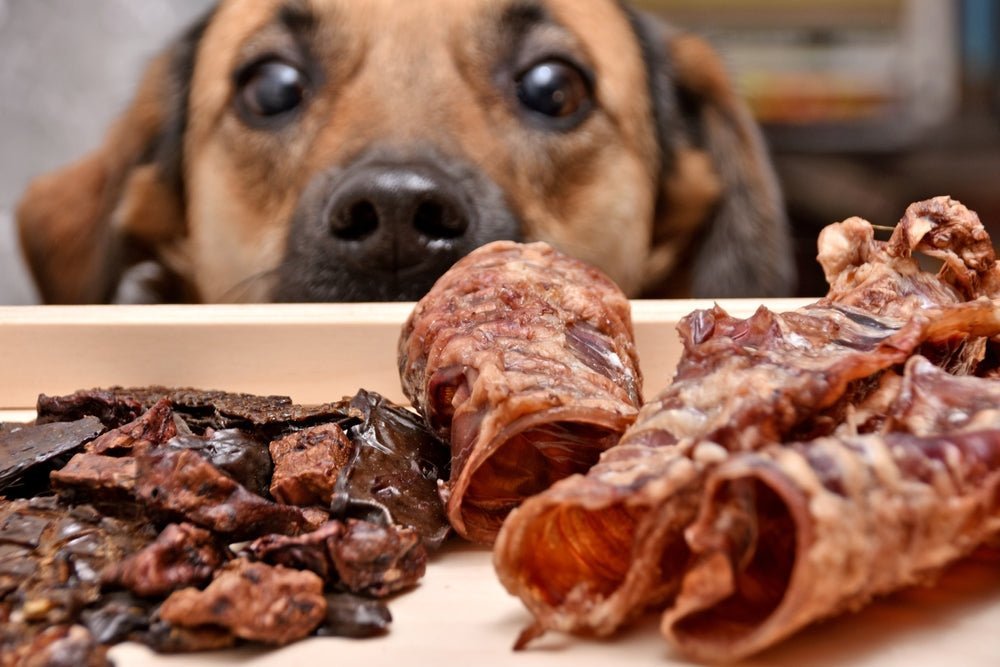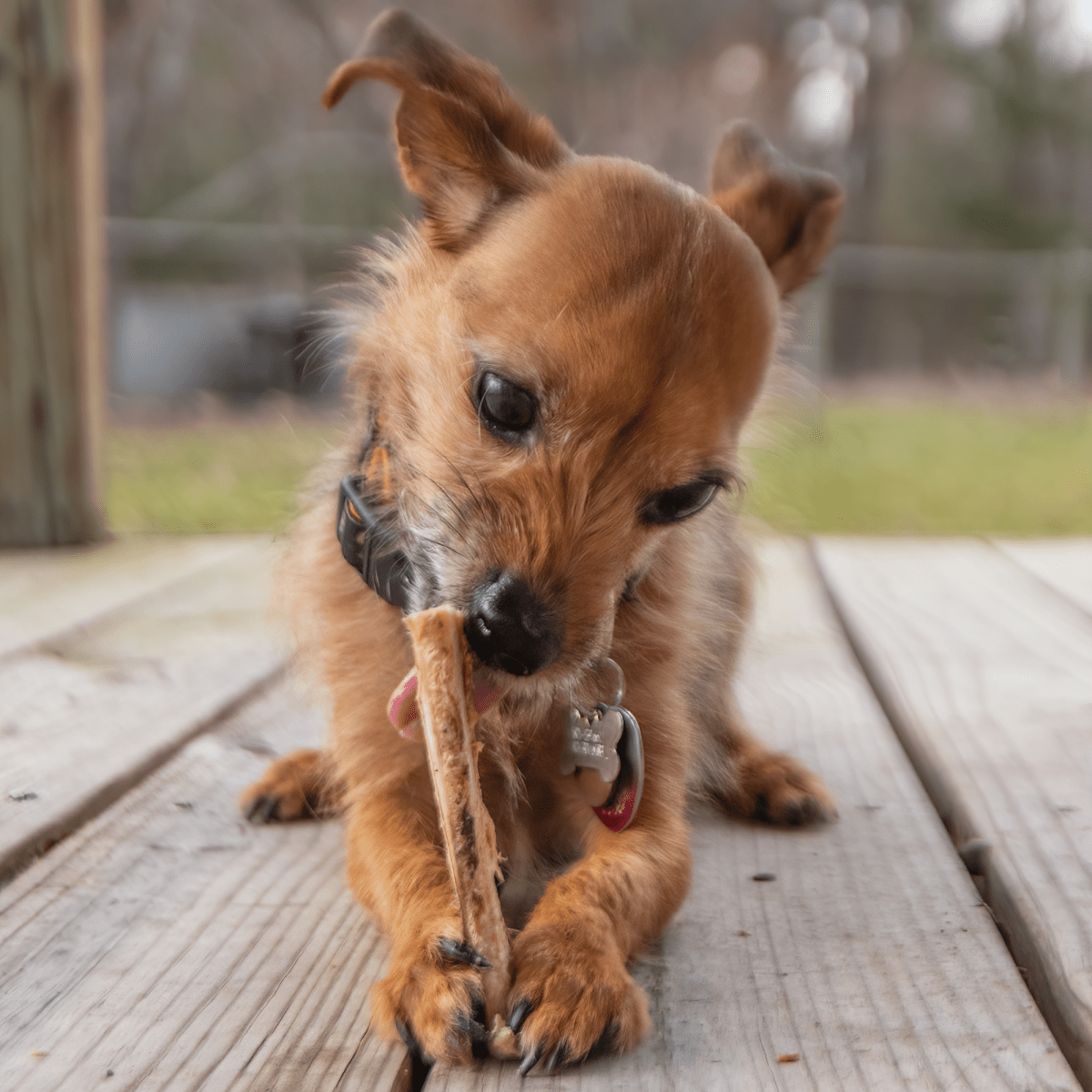
If you're a pet parent, you've likely found yourself at the pet store wondering which chew or treat is right for your dog. Between all the options available, it can get a little overwhelming. You’ve probably heard about dog chews and dog treats, but what exactly are they, and how do they differ?
Dog chews are tough, long-lasting edibles designed to satisfy your dog’s natural instinct to gnaw. Think of them like your pup’s personal stress ball—perfect for those moments when they’re feeling anxious, energetic, or just a little bored.
As your dog gnaws on these tough, long-lasting dog chew treats, it actually helps buff away that yucky plaque and tartar buildup, keeping their smile healthy and bright. Common dog chews include bully sticks, yak cheese chews, collagen chews, and even antlers. Because every dog is different, they come in a variety of shapes, sizes, and textures to suit their individual needs and the way they enjoy chewing.
What’s great about chew treats for dogs is that they’re designed to last. Unlike softer treats, they’re made to withstand even the most enthusiastic chewers. These things can keep your dog busy for ages—like, finally get-to-drink-your-coffee-while-it's-still-hot kind of peace and quiet!
Dog treats, on the other hand, are typically smaller, softer, and more focused on flavor and convenience. These treats are usually used as training tools, rewards, or just occasional snacks. They’re great for motivation but not meant to last as long as chews.
Think of dog treats as your dog’s version of a cookie—something they can enjoy quickly and with pleasure. Unlike dog chews, which are primarily about satisfying your dog’s need to chew, treats are more about rewarding your pup and keeping them happy in the moment. While these might not give their teeth quite the same workout as those tougher chews, they're often much gentler on the mouth.
While both dog chews and dog treats serve their purpose, they’re not quite the same thing. Here’s a quick breakdown of their key differences:
Longevity: Dog chews are made so your dog can really get their chew on, which is a lifesaver for keeping them entertained when you need a bit of peace and quiet. Dog treats, on the other hand, are meant for quick enjoyment and usually disappear in a few bites.
Purpose: Chews are perfect for satisfying your dog’s instinct to gnaw, while treats are often used for training, rewarding good behavior, or just as a tasty snack.
Dental Health: One of the biggest advantages of dog chews is their ability to improve dental health. Giving them those tough treats isn't just fun for them—it's actually a great way to help reduce plaque and keep their teeth healthy. Dog treats don’t offer the same benefit—they’re primarily about flavor and enjoyment.
Size and Texture: Chews tend to be much tougher and denser than treats, making them more durable for aggressive chewers. Treats, in contrast, are usually softer and can be easily broken down, which makes them more suitable for dogs who don’t chew as aggressively.
Now that we’ve covered the basics, you may be wondering when it’s appropriate to give your dog a chew versus a treat. Here’s a quick guide to help you decide!
You’ll want to give your dog a chew when they need something long-lasting to keep them occupied or when they need to satisfy their natural chewing instincts. Some situations when chews are ideal include:
When your dog needs a distraction: If your dog is bored, chewing can keep them entertained for hours. This allows your pup to use up some of that energy in a way that's actually good for them.
When you want to support dental health: One of the best things about chews is how well they help keep your dog's teeth clean and prevent that yucky tartar from sticking around.
When your dog is anxious or stressed: Chewing is a natural way for dogs to relieve anxiety, so a good chew can help them feel calm and content.
Treats are perfect for situations where you want to reward your dog, train them, or just show them a little extra love. Some great times to give your dog a treat include:
During training sessions: Treats are a fantastic motivator when teaching your dog new tricks or reinforcing good behavior.
As an occasional snack: Treats are great for keeping your dog happy in the middle of the day or just showing them that you care.
For a quick reward: Whether it’s a job well done or just because, treats are perfect for rewarding your dog in a way that’s quick and easy.
What are the best chew treats for dogs? Not all chew treats are created equal. When you're picking out chew treats for your dog, the most important thing is to go for good quality ones that will keep your little buddy safe and happy. Here’s what to keep in mind:
Natural ingredients: Look for chews made from natural, single ingredients like collagen sticks, bully sticks, or yak cheese. Avoid chews with artificial fillers or additives that could be harmful to your dog’s health.
Size-appropriate: Make sure you choose a chew that’s the right size for your dog. A small chew might be a choking hazard for a large dog, while a giant chew might be overwhelming for a smaller breed.
Single-ingredient chews: Simple is often best when it comes to chews. Chews made from just one natural ingredient—like a bully stick or collagen chew—are often the safest and healthiest options.
When in doubt, choose brands that prioritize quality and transparency over everything else. Your pup deserves the best, so always go for chews that are made with care and the highest standards.
Chewing is an important part of your dog’s health and happiness, but it’s important to do it safely. Here are some best practices to ensure that your dog’s chewing experience is both fun and safe:
Supervise chewing time: Especially for aggressive chewers, it’s important to supervise your dog while they chew to ensure they’re not chewing too aggressively or trying to swallow large pieces.
Rotate chews: Just like we get bored with the same snack every day, dogs can get tired of the same chew. A good tip is to rotate the chews your dog gets. Giving them something with a different feel or taste every now and then can really keep them engaged.
Limit daily intake: Even healthy chews can add calories, so be mindful of how many chews you give your dog each day.
Whether you’re giving your dog a chew to satisfy their gnawing instincts or a treat as a tasty reward, both options have their place in your dog’s routine. The key is knowing when to give each one and what to look for to ensure they’re getting the best quality.
Quick tip: Chews = healthy teeth, long-lasting fun, and happy chewing. Treats = training and rewards. Use them both, and you'll have a healthy, happy, and entertained furry friend!
Comments will be approved before showing up.

With so many different dog treats on the market, knowing what works best for your specific situation will save you time, money, and ensure your pup gets maximum enjoyment from every reward.

Choosing the perfect chew for your small dog can be tough, as it's not a one-size-fits-all situation. Learn about the best chew bones for your small dog here!